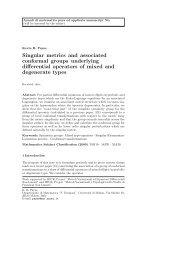Asymptotic behaviour of the Kazdan-Warner solution in the annulus ∗
Asymptotic behaviour of the Kazdan-Warner solution in the annulus ∗
Asymptotic behaviour of the Kazdan-Warner solution in the annulus ∗
You also want an ePaper? Increase the reach of your titles
YUMPU automatically turns print PDFs into web optimized ePapers that Google loves.
Lemma 2.7. Let ū <strong>the</strong> function def<strong>in</strong>ed <strong>in</strong> (2.13). Then we have<br />
and<br />
ū(r) < 1 for any r = r0 (2.17)<br />
ū(r0) = 1 (2.18)<br />
Pro<strong>of</strong>. By Lemma 2.6 we have that ū(r) ≤ 1. Let us suppose that <strong>the</strong>re exists<br />
r ′ = r0 such that ω(r ′ ) = 1. S<strong>in</strong>ce u ′ p(r) is <strong>in</strong>creas<strong>in</strong>g <strong>in</strong> [a, rp] we have that<br />
ū(r) ≡ 1 for any r ∈ (r ′ , r0). By (2.10) we can pass to <strong>the</strong> limit <strong>in</strong> (2.11) and<br />
<strong>the</strong>n ū satisfies<br />
− ū ′′ −<br />
N − 1<br />
ū<br />
r<br />
′ = 1 <strong>in</strong> (r ′ , r0) (2.19)<br />
This leads to a contradiction with ū(r) ≡ 1 <strong>in</strong> r ∈ (r ′ , r0). This proves (2.17).<br />
F<strong>in</strong>ally (2.18) follows by (2.8). ⊓⊔<br />
Pro<strong>of</strong> <strong>of</strong> <strong>the</strong> Theorem 1.1<br />
Let us consider only <strong>the</strong> case N ≥ 3 (<strong>the</strong> case N = 2 is analogous).<br />
By (2.10) and Lemma (2.6) we can pass to <strong>the</strong> limit <strong>in</strong> (2.11). Then <strong>the</strong><br />
limit ū satisfies ⎧ ⎪⎨<br />
−ū ′′ − N−1<br />
r ū′ = 0 <strong>in</strong> (a, r0)<br />
⎪⎩<br />
ū(a) = 0, ū(r0) = 1<br />
(2.20)<br />
and <strong>the</strong> same happens for r ∈ (r0, b). A straightforward computation shows<br />
that ū = ω. We f<strong>in</strong>ish <strong>the</strong> pro<strong>of</strong> comput<strong>in</strong>g <strong>the</strong> value <strong>of</strong> r0.<br />
By Proposition 2.4 we have that up converges strongly to ω <strong>in</strong> H1 0(a, b).<br />
Then<br />
<br />
2 <br />
Ω |∇up|<br />
Ipn = =<br />
<br />
Ω<br />
Ω up p<br />
2<br />
p<br />
|∇ω| 2 = (2 − N)ωN<br />
|∇up|<br />
Ω<br />
2<br />
2 1− p<br />
≥<br />
<br />
1<br />
b2−N +<br />
− |r0| 2−N<br />
1<br />
|r0| 2−N − a2−N <br />
(2.21)<br />
If r 2−N<br />
0 = a2−N +b 2−N<br />
1<br />
2 we deduce that b2−N −|r0| 2−N 1 + |r0| 2−N −a2−N > 4(2−N)<br />
b2−N −a2−N and this is a contradiction with Proposition 2.1. Hence r 2−N<br />
0 = a2−N +b 2−N<br />
2 ant<br />
this f<strong>in</strong>ishes <strong>the</strong> pro<strong>of</strong> ⊓⊔<br />
Pro<strong>of</strong> <strong>of</strong> Theorem 1.3<br />
It follows by Theorem 1.1 observ<strong>in</strong>g that<br />
<br />
Ω |∇u|2<br />
<br />
2 |∇up| Ω<br />
<br />
≥ Cp = Ω<br />
up+1 2<br />
p+1<br />
7<br />
Ω up+1 p<br />
2<br />
p+1<br />
<br />
→<br />
Ω<br />
|∇ω| 2 . (2.22)








